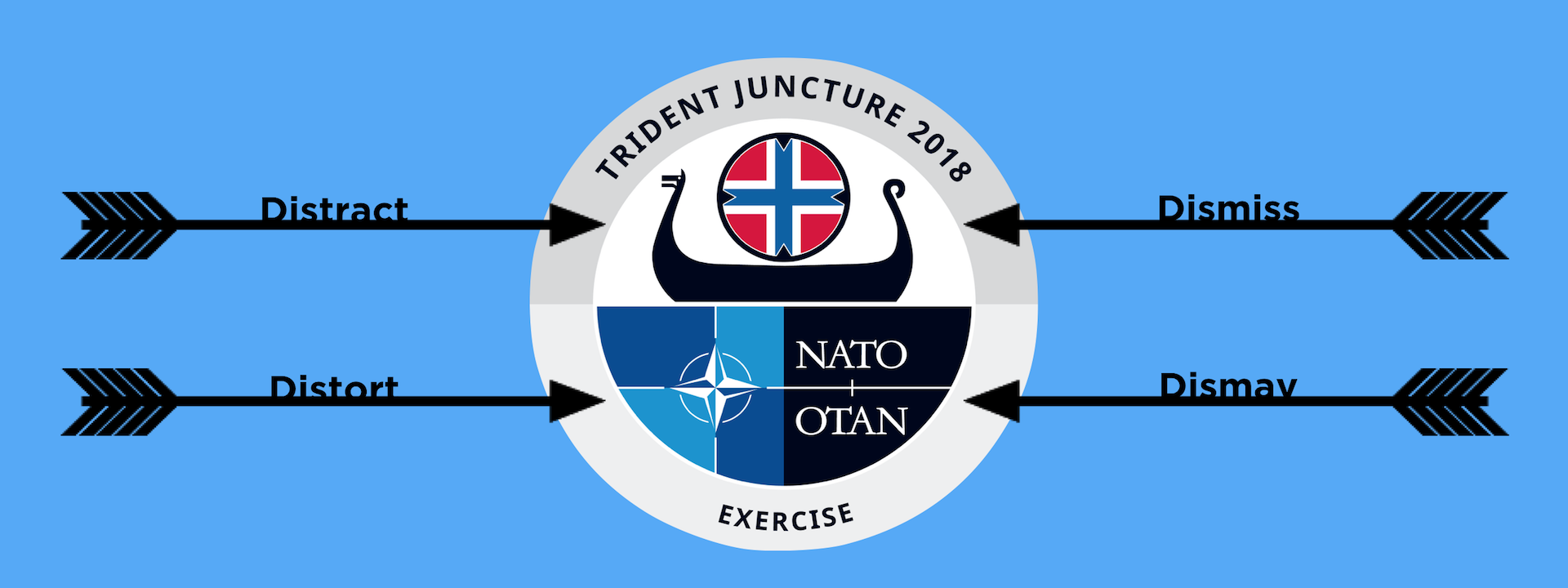#PutinAtWar: Disinformation Targets Trident Juncture
NATO’s largest exercise becomes the target of Kremlin’s 4Ds of disinformation
#PutinAtWar: Disinformation Targets Trident Juncture

NATO’s largest exercise becomes the target of Kremlin’s 4Ds of disinformation

A regular military exercise conducted by NATO this month has been the target of a familiar pattern of Russian disinformation.
Trident Juncture is NATO’s largest exercise since the end of the Cold War. 50,000 personnel from 31 NATO and partner countries are training to defend allies from a foreign invasion by a fictional adversary. The two-week long exercise is taking place in Norway and will end on November 7. The exercise is supported by 10,000 vehicles, 250 aircraft, and 65 vessels, including the American aircraft carrier USS Harry S. Truman. According to NATO, the goal of the Trident Juncture is to test the ability of NATO member states to defend their territories and populations, deter potential adversaries, and test alliance’s interoperability.
Before the exercise began, Kremlin-controlled media outlets and the Kremlin itself started an influence campaign, following a familiar pattern of the 4Ds of disinformation, which consist of dismissing, dismaying, distorting, and distracting.
Distort
The tactic to distort was the most salient used by Kremlin-controlled media outlets and Russian government representatives when discussing the exercise. Produced narratives primarily focused on distorting the goal of the exercise and attempting to portray NATO as an aggressor in the region by provoking Russia and threatening Russian sovereignty.
Trident Juncture is a defensive exercise, as NATO made clear in a number of press briefings and NATO-Russia Council meetings earlier this year. The core exercise involved 50,000 personnel and an area at least 1,000 kilometers away from Russia’s border.
Unlike some Russian exercises, Trident Juncture 2018 complies with OSCE’s Vienna Document 2011, therefore, OSCE member states were notified of the exercise 42 days before it took place and OSCE member states — including Russia — were invited to observe the exercise.
In contrast, the Russian-Belarussian joint military exercise Zapad 2017 involved up to 100,000 soldiers, took place as close as 100 kilometers away from Estonia’s border and was not compliant with the Vienna Document due to the intentionally deflated number of troops participating.
Nevertheless, on October 24, Russian Minister of Defense Sergey Shoigu claimed NATO’s exercise is offensive, rather than defensive, and added that NATO is exercising “near Russia’s border”. Neither one of these statements were truthful.
Shoigu’s statements were echoed by the Kremlin-funded RT, Sputnik and a number of pro-Kremlin news outlets publishing in English, Russian and German languages, among others.



Dismiss
Like distortion of facts, dismissal of NATO’s military capabilities was another prominent tactic used by the Kremlin-funded media. In stark contrast to accusing NATO of being the aggressor, however, dismissals focused on the idea that NATO cannot defend its allies, let alone stand up to Russia’s military might. As a result, the Kremlin and its media outlets were simultaneously arguing that NATO is a national security threat to Russia and that NATO is weak and cannot defend itself.
Riafan, a Russian news outlet known to be an offshoot of the Internet Research Agency (a Russian troll factory) published an article titled: “An elephant that cannot fight: Why NATO invited Russia to observe its exercise”

The author wrote:
In terms of military exercises, Russia is setting the tempo and Western countries have to respond to it, showing their capabilities. The Vostok 2018 maneuvers have become an unattainable height for NATO in this regard.
A similar sentiment was reflected in RT’s and Pravda.ru coverage of the exercise.


Dismay
Russia’s attempts at dismay centered around a highly publicized deployment in response to NATO’s exercise.
The Russian Ministry of Defense announced it will deploy the Samarkand electronic warfare systems in 13 Russia’s military units, including one in Kaliningrad, which borders both Lithuania and Poland.
Samarkand is an electronic warfare system. According to Kremlin-controlled and pro-Kremlin media, it can neutralize NATO’s command and control systems.




Distract
To distract from Trident Juncture’s objectives in Norway, a network of pro-Kremlin media outlets spoke extensively about the “real threat” facing NATO, which they argued is not Russia but terrorism.
A network of conspiracy websites with a predilection for sharing pro-Kremlin stories published the same article about Trident Juncture. ZeroHedge, Strategic Culture Foundation, The Russophile, The Truth Seeker and Peoples Trust Toronto published an article titled “‘Trident Juncture 2018’ About To Kick Off: NATO’s Big War Games Near Russia’s Borders Never End”.
In the article the author Alex Gorka, a defense and diplomacy analyst at the Strategic Culture Foundation, said, “these never-ending exercises adjacent to Russia’s borders show that the terrorist threat has been forgotten”.
The article did not mention the multitude of ongoing NATO counterterrorism initiatives, such as the Training and Capacity Building Mission in Iraq, a new project named EXTRAS designed to help detect explosives in public transport, and an initiative to support Iraq’s civil-military cooperation in dealing with terrorist challenges.
Traction
Despite the large numbers of published articles criticizing Trident Juncture, the coverage failed to dominate the conversation on NATO’s exercise online. According to Buzzsumo, Kremlin-controlled and pro-Kremlin media outlets accounted for approximately 15 percent of articles about NATO between October 2 and November 2, while mainstream and Western media outlets dominated the vast majority of conversations about NATO online.

Conclusion
The Russian government and media response to NATO’s Trident Juncture is yet another case of how integrated the Kremlin’s disinformation apparatus remains. It also showed the contradictory nature of its narratives on NATO and Trident Juncture 2018. On the one hand, the Kremlin and its media outlets argue that NATO is threatening Russia’s security, while simultaneously claiming that NATO cannot defend its own allies or stand up to Russia’s military might.
Follow along for more in-depth analysis from our #DigitalSherlocks.

